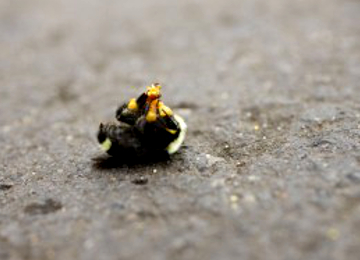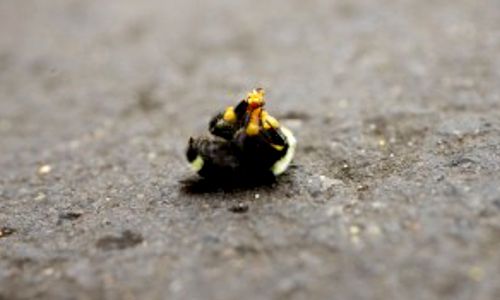

Beyond Pesticides
Just as Pollinator Week began last week, an estimated 50,000 bumblebees, likely representing more than 300 colonies, were found dead or dying in a shopping mall parking lot in Wilsonville, OR. Authorities confirmed Friday that the massive bee die-off was caused by the use of a neonicotinoid pesticide, dinotefuran, on nearby trees. Then on Saturday, it was reported by The Oregonian that what could be hundreds of bees were found dead after a similar pesticide use in the neighboring town of Hillsboro.
According to the Xerces Society, this is the largest known incident of bumblebee deaths ever recorded in the country. Bumblebees, which are crucial to the pollination of multiple berry and seed crops grown in the Willamette valley—as well as many other food crops across the country—have recently experienced dramatic population declines, a fate similar to other pollinators.
Dan Hilburn, director of plant programs at the Oregon Department of Agriculture (ODA), told Oregon Live that he’s “never encountered anything quite like it in 30 years in the business.” The incident highlights the difficulty of permitting in commerce such a highly toxic material that indiscriminately kills beneficial insects.
A recent study—an overview of the environmental risks posed by neonicotinoid insecticides—published in the Journal of Applied Ecology, documents that neonicotinoid persistence in soil and water can cause broad, far-reaching impacts on ecosystem health, much of which has undergone little scientific scrutiny. The author asserts that world leaders have failed to meet their commitment made at the 2002 Convention on Biological Diversity—to achieve a significant reduction in the rate of biodiversity loss. David Goulson, Ph.D, of the University of Sussex, author of the study, points to neonicotinoids as a potential cause of this failure, due to their long-term persistence in soil and water. He specifically points to soil dwelling insects, benthic aquatic insects, grain-eating vertebrates and pollinators as being in particular danger from the use of these chemicals.
The ODA and Xerces Society had been working together to investigate the pesticide poisoning. After interviewing the landscaping company that maintains dozens of ornamental trees around the parking lot, the ODA investigators learned that Safari, a pesticide product with the active ingredient dinotefuran, had recently been applied on June 15 to control aphids. Dinotefuran is a neonicotinoid pesticide that is highly toxic to bees; the product’s label strictly forbids its use if bees are in the area.
Scott Black, executive director of the Xerces Society, noted that the pesticide was applied to the tree while it was flowering, an action that violates the product’s instructions.
“Beyond the fact that a pesticide was applied to plants while they were attracting large numbers of bees, in this case the pesticide was applied for purely cosmetic reasons. There was no threat to human health or the protection of farm crops that even factored into this decision,” stated Black.
Neonicotinoids, including dinotefuran, can be broadly applied as a spray, soil drench or seed treatment, however, the ability of these chemicals to translocate through a plant as it grows has led to the creation of a large market within chemical-intensive landscaping and agriculture. Once these systemic pesticides are taken up by a plant’s vascular system, they are expressed through pollen, nectar and guttation droplets from which pollinators such as bees then forage and drink. Neonicotinoids kill sucking and chewing insects by disrupting their nervous systems.
Beginning in the late 1990s, these systemic insecticides also began to take over the seed treatment market. Clothianidin and imidacloprid are two of the most commonly used neonicotinoid pesticides. Both are known to be toxic to insect pollinators, and are lead suspects as causal factors in honey bee colony collapse disorder. An extensive overview of the major studies showing the effects of neonicotiniods on pollinator health can be found in Beyond Pesticides’ What the Science Shows.
Several different crops in the Willamette valley of Oregon rely heavily on the pollination services provided by bumblebees. Blueberries, raspberries, blackberries and crop seed production, which are grown in Oregon, all rely on bumblebees for pollination. Mace Vaughn, pollinator conservation program director with the Xerces Society, told Oregon Live, “Bumblebees are the single most important natural pollinator in Oregon.”
In the midst of the all the attention that is focused on the loss of honey bees and colony collapse disorder, wild pollinator losses are often overlooked. Pesticide risk mitigation measures intended to protect honey bees do not always constitute risk mitigation for other pollinators like bumblebees because they have different foraging practices, social structures and genetics. Minimal research has also been done on pesticide toxicity for wild pollinators.
This massive bee death marked an unfortunate beginning to National Pollinator Week, which was first declared in 2006 by Congress and the U.S. Department of Agriculture to raise awareness about the global decline of many pollinator species. During Pollinator Week and year round, Beyond Pesticides urges communities to come together to highlight the importance of pollinators through public education, the creation of pollinator friendly habitats and other important activities, while hundreds of actions to support pollinators took place across the U.S.
Though pollinator week is over, there are still many ways that you can get involved and help protect pollinators, from providing bee habitat in your yard, to keeping bees in your backyard or simply choosing to eat organic foods. Beyond Pesticides’ BEE Protectivecampaign has all the educational tools you need to help pollinators.
Visit EcoWatch’s BIODIVERSITY page for more related news on this topic.

 233k
233k  41k
41k  Subscribe
Subscribe 

